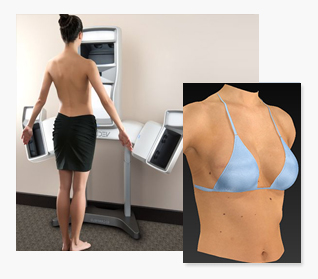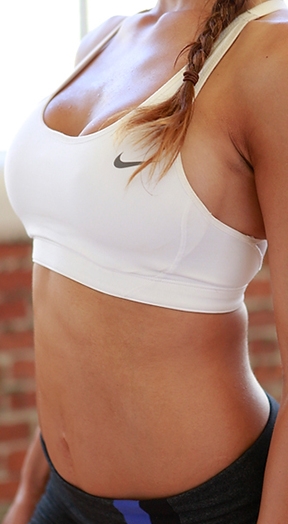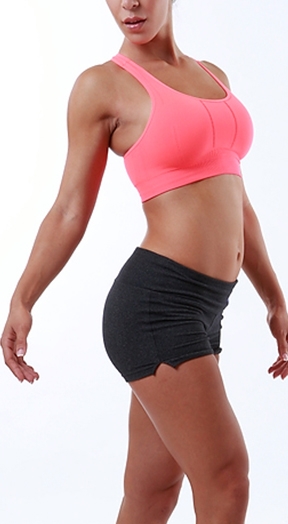When patients have drooping nipples that point downward and a loose skin envelope, they may be unhappy with the overall appearance of the breasts. These problems are common in older women and those who have previously been pregnant or breastfed. One way to correct these aesthetic issues is through surgical intervention. With breast lift surgery, Bay Area plastic surgeon John R. Griffin can reposition the nipples and remove excess skin to restore a more youthful look to the breasts.
Vectra 3D Imaging for Breast Lift
|
Vectra 3D imaging technology helps women visualize their potential individual outcomes. During the breast lift consultation, Dr. Griffin will take a 3D image of the patient. Once the image is displayed on his computer screen, Dr. Griffin can model the procedure and simulate their results with greater accuracy. The simulated images can be viewed from all angles, giving patients a better idea of what their surgical results could look like. |
Candidates
Candidates for breast lift surgery should be finished having children and breastfeeding. They should also be in good health, not smoke, and have realistic expectations.
In terms of aesthetics, breast lift surgery can be performed on patients with minor, moderate, and severe breast ptosis. Generally, patients will have low hanging breasts as a result of overstretched skin, and the nipple will have moved down the slope of the breasts, further contributing to a sagging appearance.
During the patients consultation visit, Dr. Griffin will use Vectra 3D imaging technology, which allows patients to preview potential surgical plans and outcomes.
Techniques
There are four incision techniques that can be performed to lift the breasts:
- The crescent incision: This approach is best suited to patients with a minor degree of sagging. In patients who undergo the crescent lift, a crescent-shaped portion of skin is removed from the upper areola. This allows for a small amount of skin removal to slightly tighten the skin envelope. Placement of an implant provides further lift to the breast. The location of the nipple is not moved with this technique.
- The doughnut incision or circumareolar: The doughnut technique can be performed on patients with small amounts of breast ptsosis. In this approach, the surgeon can make an incision around the perimeter of the areola to remove skin, reposition the nipple, and reduce the size of the areola.
- The lollipop or kiel incision: The lollipop incision is appropriate for patients with moderate degrees of breast sagging. An incision is made around the areola, and then down the center of the breast, resembling a lollipop. Through these incisions, excess skin can be removed, and the nipple can be moved up the fold of the breast.
- The anchor or wise pattern incision: The anchor incision is performed on patients with higher degrees of breast ptosis. This technique includes the incision around the areola, down the center of the breast, and then an additional horizontal incision along the inframammary crease; the incisions resemble an anchor. These incisions allow for the greatest amount of skin removal, and the nipple can be repositioned.
Procedure Steps
The breast lift procedure is performed as follows.
- The breast incisions are marked with a surgical pen
- The patient is put under general anesthesia
- Antibacterial solution is applied to the breasts
- The incisions are made
- The skin envelope is tightened by removing excess skin
- The skin is re-draped over the breast mound
- The nipple is repositioned
- The size of areola may be reduced
- The incisions are closed
- Bandages are applied to the breasts
Recovery
Patients who undergo breast lift surgery typically take one week off of work to recover. During this initial healing period, the patients should take it easy while the worst of the side effects fade. After about a week, the patient will return to Dr. Griffin’s office so he can remove stitches and check the patient’s healing progress.
For six weeks after surgery, patients should avoid heavy exercise or lifting, and wear a surgical bra to promote healing. Once the three- to six-week healing period is over, patients can return to all regular activities.
Side Effects
Most of the side effects from surgery, with the exception of swelling, fade one to two weeks after surgery. Swelling can be expected to last for a couple of months. The side effects of surgery include:
- Discomfort
- Bruising
- Swelling
- Itching at the incision site
- Numbness of the incision site
Risks
Complications, though rare, can occur after breast lift surgery. Possible risks include:
- Infection
- Allergic reaction to anesthesia, healing aids, or medications
- Permanent nerve damage resulting in skin or nipple numbness
- Hematoma
- Seroma
- Unfavorable scarring
- Breast asymmetry
Results
The results of breast lift surgery are evident immediately after surgery. However, they will be obscured by bandages for the first week after surgery, and swelling, which may take a couple of months to complete subside. Patients who live a healthy lifestyle can expect the results of breast lift surgery to last a decade or more.
Consultations
To schedule a breast lift consultation, contact Dr. Griffin’s practice today.








